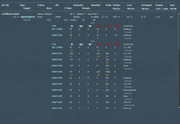GloriousRuse
Posts: 906
Joined: 10/26/2013
Status: offline

|
An item of clarification - that is actually a 500x aircraft AS for the LW, which I now see the photo doesn't show. The allied battle report is inflating the numbers pretty dramatically. To that end, the LW basically has enough aircraft to either set two of these up, set one truly massive thousand fighter attack up (you struggle to base more than this close enough to matter), and leave 400 second class formations as the thin cover else where.
As to Loki's well made points:
A) Yes, this does not prove the night fighters are efficacious. They seem to operate much like the ZGs, which makes sense given they are mostly the same airframes. Alone, they are easy meat. Packed in behind single engine fighters, they add some serious killing weight to the mission. To the allied side though, it is clear that the Mosquitos and Beaufighters mostly rely on outnumbering the smaller intercepts the Germans send up and don't have the weight of numbers or aircraft performance to stay in a contested day campaign. Half of BC's inventory is gone in one bad raid. I dare say 110 P-38s would have killed more and lost less in this exchange - and had far more replacements coming down the pipe.
B) The long term question is one of strategy. BC east of the Ruhr no longer has FC sweeping for it, and is very exposed to a daylight hit as a result. At which point it is playing 8th AAF cat and mouse, only with worse tools for the job. Or the 8th re-designates its precious long range escorts to assist BC, opening up holes somewhere else. If the allies pull it off successfully, it isn't because the combat model screwed the Germans. If BC stays over the Ruhr under FC coverage, they telegraph pretty hard and the odds of taking a crippling hit like this go up. Moreover, the decision loop allows the Germans to put in an air ambush and then redeploy or go to ground before the next allied decision.
As for the Germans, it means putting more of the LW on the line in '43. But that isn't inherently invalid - the combat model lets them deal killer hits to the BC by day if done well, presumably slowing VP gain down. And if the German is willing to concede the day time airspace when the combat model is legitimate, he is doing it for strategic reasons.
Essentially, BC going in by day ups the risk ante, and the German has to stay in the hand or fold. And so long as staying in the hand is not unrealistically constrained by the game mechancis, it is a plyer decision driving who gets what VPs, not a mechanical error.
C) As far as VP, as your trials concluded, day bombing does more damage per bomb dropped. Which seems accurate to reality. This higher per bomb drop comes at the risk of annihilation that the brits have a longer refill delay on. I guess the point here is that we reward players with VP for achieving things. If the BC can bomb in daylight while the combat model says they take serious risks for doing so, it means they've achieved air superiority over west Germany by '43 - well exceeding their historical analogs. That is a success, just like taking Rome before June of '44. The fact that they earn more VP for a success, given the combat model isn't handing it to them by default, seems to be in keeping with the idea of VP? I agree that there are political and organizational constraints that would have changed this course of action in reality, but that is true of a great many of the decisions WitW lets players make.
|
 Printable Version
Printable Version











 !
! 
 New Messages
New Messages No New Messages
No New Messages Hot Topic w/ New Messages
Hot Topic w/ New Messages Hot Topic w/o New Messages
Hot Topic w/o New Messages Locked w/ New Messages
Locked w/ New Messages Locked w/o New Messages
Locked w/o New Messages Post New Thread
Post New Thread